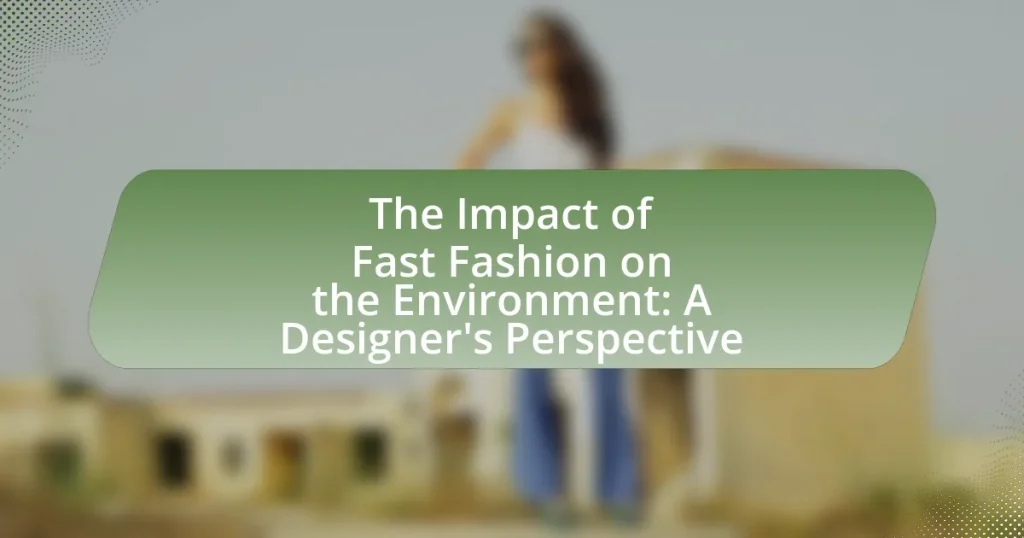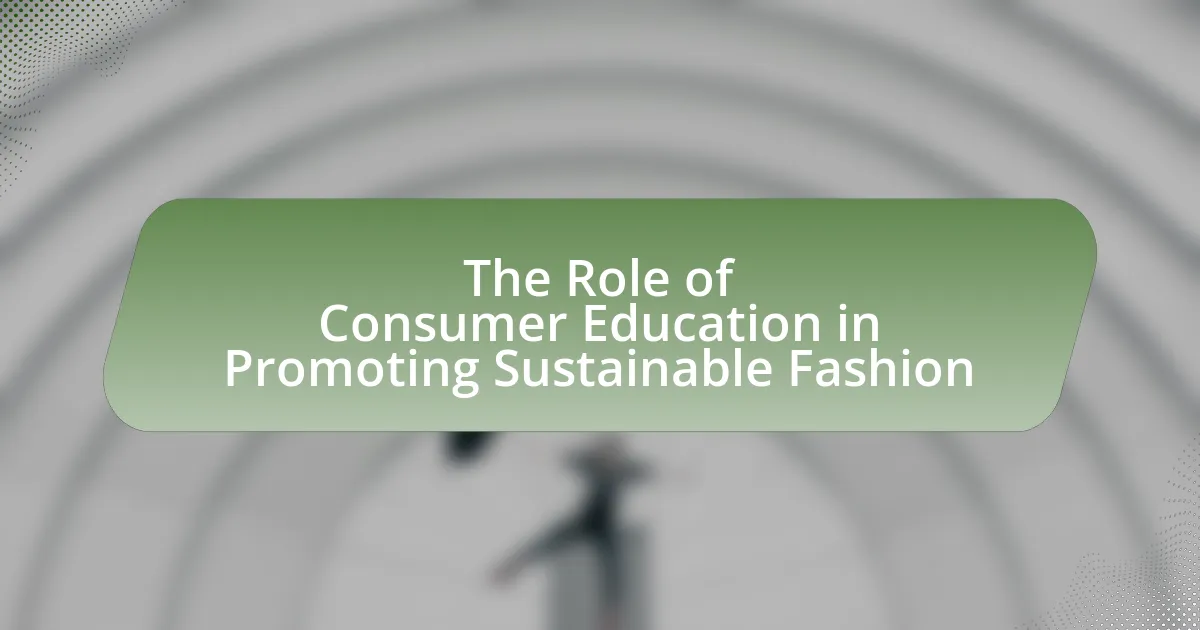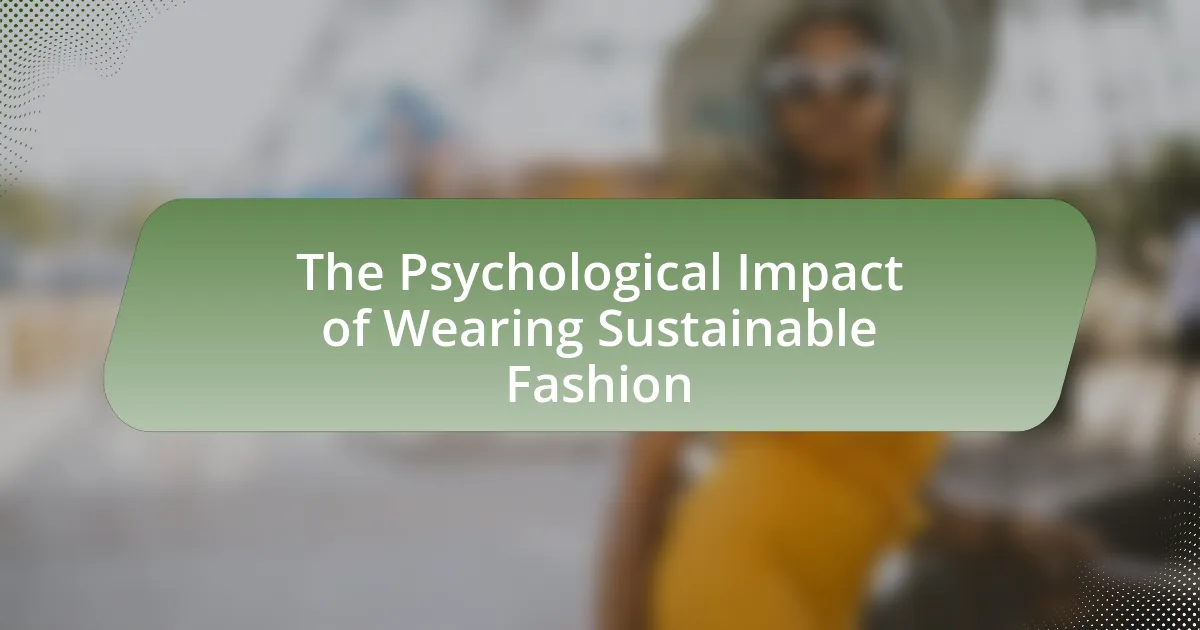The article examines the environmental impact of fast fashion, highlighting its significant contributions to pollution, waste, and resource depletion. It details how the fashion industry is responsible for 10% of global carbon emissions, excessive water consumption, and the generation of approximately 92 million tons of textile waste annually. The piece also explores the role of designers in promoting sustainable practices, the challenges they face, and the importance of consumer behavior in driving demand for eco-friendly alternatives. Additionally, it discusses potential solutions for reducing fast fashion’s environmental footprint, including the adoption of circular economy principles and the need for collaboration among designers, brands, and consumers.

What is the impact of fast fashion on the environment?
Fast fashion significantly harms the environment by contributing to pollution, waste, and resource depletion. The production of fast fashion items involves the use of toxic chemicals, which can contaminate water sources and harm ecosystems. For instance, the fashion industry is responsible for 20% of global wastewater, primarily due to dyeing processes. Additionally, fast fashion leads to massive textile waste; approximately 92 million tons of textiles are discarded each year, much of which ends up in landfills. The rapid production cycles also result in excessive water consumption, with the industry using around 93 billion cubic meters of water annually, enough to meet the needs of five million people. These factors collectively illustrate the detrimental impact of fast fashion on the environment.
How does fast fashion contribute to environmental degradation?
Fast fashion contributes to environmental degradation primarily through excessive resource consumption and waste generation. The industry is responsible for producing over 92 million tons of textile waste annually, much of which ends up in landfills. Additionally, fast fashion relies heavily on water-intensive processes; for instance, producing a single cotton shirt can require up to 2,700 liters of water, exacerbating water scarcity issues. Furthermore, the use of synthetic fibers, such as polyester, leads to microplastic pollution, with an estimated 500,000 tons of microfibers entering oceans each year from washing garments. These factors collectively illustrate how fast fashion significantly harms the environment.
What are the primary environmental issues caused by fast fashion?
The primary environmental issues caused by fast fashion include excessive waste generation, high water consumption, and significant carbon emissions. Fast fashion brands produce millions of garments annually, leading to approximately 92 million tons of textile waste disposed of in landfills each year. The production processes consume around 2,700 liters of water per t-shirt, contributing to water scarcity in many regions. Additionally, the fast fashion industry is responsible for about 10% of global carbon emissions, primarily due to energy-intensive manufacturing and transportation practices. These statistics highlight the severe environmental impact of fast fashion on ecosystems and resources.
How does fast fashion affect natural resources?
Fast fashion significantly depletes natural resources by promoting rapid production cycles that require vast amounts of water, energy, and raw materials. For instance, the production of a single cotton t-shirt can consume approximately 2,700 liters of water, which is enough for one person to drink for two and a half years. Additionally, the fast fashion industry is responsible for around 10% of global carbon emissions, primarily due to the energy-intensive processes involved in manufacturing and transportation. This unsustainable demand leads to deforestation, soil degradation, and the over-extraction of resources, further exacerbating environmental degradation.
Why is it important to address the environmental impact of fast fashion?
Addressing the environmental impact of fast fashion is crucial because it significantly contributes to pollution, resource depletion, and waste generation. The fast fashion industry is responsible for 10% of global carbon emissions, which is more than the emissions from international flights and maritime shipping combined. Additionally, it consumes vast amounts of water; for instance, producing a single cotton t-shirt requires approximately 2,700 liters of water. Furthermore, fast fashion leads to massive textile waste, with an estimated 92 million tons of textiles discarded annually, much of which ends up in landfills. These facts underscore the urgent need to mitigate the environmental consequences associated with fast fashion to promote sustainability and protect natural resources.
What are the long-term consequences of ignoring fast fashion’s environmental effects?
Ignoring fast fashion’s environmental effects leads to severe long-term consequences, including increased pollution, resource depletion, and climate change. The fashion industry is responsible for 10% of global carbon emissions, which contributes significantly to global warming. Additionally, fast fashion generates approximately 92 million tons of textile waste annually, overwhelming landfills and harming ecosystems. Water usage is also critical; the industry consumes around 93 billion cubic meters of water each year, exacerbating water scarcity issues in many regions. These factors collectively threaten biodiversity, disrupt natural habitats, and pose risks to human health, demonstrating the urgent need for sustainable practices in fashion.
How does consumer behavior influence the environmental impact of fast fashion?
Consumer behavior significantly influences the environmental impact of fast fashion by driving demand for inexpensive, trendy clothing that is often discarded after minimal use. This high turnover rate leads to increased production, which in turn results in greater resource consumption and waste generation. For instance, the Ellen MacArthur Foundation reports that the fashion industry is responsible for 10% of global carbon emissions, largely due to consumer preferences for rapid consumption and disposal of garments. Additionally, consumers’ tendency to prioritize low prices over sustainability encourages brands to adopt environmentally harmful practices, such as using non-biodegradable materials and exploiting labor in countries with lax environmental regulations. Thus, consumer choices directly correlate with the environmental degradation associated with fast fashion.
What is a designer’s perspective on fast fashion’s environmental impact?
A designer’s perspective on fast fashion’s environmental impact is that it contributes significantly to pollution and waste. Designers recognize that the fast fashion industry is responsible for approximately 10% of global carbon emissions, largely due to the rapid production cycles and the use of synthetic materials that do not biodegrade. Additionally, the industry generates massive amounts of textile waste, with an estimated 92 million tons discarded annually, which often ends up in landfills. This perspective emphasizes the urgent need for sustainable practices, such as using eco-friendly materials and promoting circular fashion, to mitigate these detrimental effects on the environment.
How do designers perceive their role in mitigating fast fashion’s effects?
Designers perceive their role in mitigating fast fashion’s effects as crucial in promoting sustainable practices and ethical consumption. They recognize that their design choices significantly influence production processes, material selection, and consumer behavior. For instance, many designers advocate for the use of eco-friendly materials and sustainable manufacturing techniques to reduce environmental impact. Research indicates that the fashion industry is responsible for 10% of global carbon emissions, highlighting the urgency for designers to adopt sustainable practices. By prioritizing longevity and quality in their designs, they aim to shift consumer mindsets away from disposable fashion towards more responsible consumption.
What sustainable practices can designers adopt in their work?
Designers can adopt sustainable practices such as using eco-friendly materials, implementing waste reduction strategies, and promoting ethical production methods. By selecting organic, recycled, or biodegradable fabrics, designers minimize environmental impact and reduce reliance on harmful chemicals. Additionally, employing techniques like zero-waste design and upcycling helps to decrease textile waste, which is a significant issue in the fashion industry. Furthermore, collaborating with manufacturers that adhere to fair labor practices ensures that the production process is ethical and sustainable. These practices not only contribute to environmental conservation but also align with the growing consumer demand for sustainable fashion, as evidenced by a 2021 McKinsey report indicating that 67% of consumers consider sustainability when making a purchase.
How can designers influence consumer choices towards sustainability?
Designers can influence consumer choices towards sustainability by integrating eco-friendly materials and practices into their designs. By prioritizing sustainable fabrics, such as organic cotton or recycled polyester, designers not only reduce environmental impact but also educate consumers about the benefits of these materials. Research indicates that 66% of consumers are willing to pay more for sustainable brands, highlighting the potential for designers to drive demand for eco-conscious products. Furthermore, designers can promote transparency in their supply chains, allowing consumers to make informed choices about the environmental and social implications of their purchases. This approach not only fosters brand loyalty but also encourages a shift in consumer behavior towards more sustainable practices.
What challenges do designers face in promoting sustainable fashion?
Designers face significant challenges in promoting sustainable fashion, primarily due to consumer demand for fast fashion, which prioritizes low cost and rapid production over sustainability. This demand creates pressure on designers to produce collections quickly, often leading to compromises in ethical sourcing and environmentally friendly practices. Additionally, the lack of awareness and understanding among consumers about the environmental impact of their purchasing decisions further complicates designers’ efforts to advocate for sustainable alternatives. According to a 2021 report by McKinsey & Company, 66% of consumers are not aware of the environmental impact of their clothing choices, highlighting the need for education in promoting sustainable fashion.
How do market demands conflict with sustainable design practices?
Market demands often conflict with sustainable design practices by prioritizing rapid production and low costs over environmentally friendly materials and processes. Fast fashion brands, driven by consumer desire for trendy, inexpensive clothing, frequently opt for synthetic fabrics and mass production techniques that contribute to pollution and waste. For instance, the Ellen MacArthur Foundation reports that the fashion industry is responsible for 10% of global carbon emissions, highlighting the environmental impact of prioritizing market demands over sustainability. This conflict creates a cycle where the pressure to meet consumer expectations undermines efforts to implement eco-friendly practices in design and production.
What barriers exist for designers aiming to shift away from fast fashion?
Designers face several barriers when attempting to shift away from fast fashion, primarily including economic constraints, consumer demand, and supply chain limitations. Economic constraints arise from the higher costs associated with sustainable materials and ethical production practices, which can deter designers from making the transition. Consumer demand for low-cost, trendy items perpetuates fast fashion, making it challenging for designers to promote sustainable alternatives that may be priced higher. Additionally, supply chain limitations hinder access to sustainable materials and ethical manufacturing processes, as many existing infrastructures are optimized for fast fashion production. These barriers collectively create significant challenges for designers committed to sustainability in the fashion industry.
What are the solutions to reduce fast fashion’s environmental impact?
To reduce fast fashion’s environmental impact, implementing sustainable practices such as using eco-friendly materials, promoting circular fashion, and encouraging responsible consumer behavior is essential. Eco-friendly materials, like organic cotton and recycled polyester, significantly lower water usage and chemical pollution compared to conventional fabrics. Circular fashion, which includes recycling and upcycling garments, minimizes waste by extending the lifecycle of clothing. Additionally, educating consumers about the environmental consequences of their purchasing decisions can lead to more mindful consumption, reducing demand for fast fashion. According to the Ellen MacArthur Foundation, transitioning to a circular economy in fashion could reduce greenhouse gas emissions by 44% by 2030.
How can the fashion industry transition towards sustainability?
The fashion industry can transition towards sustainability by adopting circular economy principles, which emphasize reducing waste and reusing materials. Implementing practices such as using organic or recycled fabrics, minimizing water consumption, and ensuring ethical labor conditions can significantly lower the environmental impact. For instance, the Ellen MacArthur Foundation reports that transitioning to a circular economy in fashion could reduce global carbon emissions by 44% by 2030. Additionally, brands like Patagonia and Stella McCartney exemplify sustainable practices by prioritizing eco-friendly materials and transparent supply chains, demonstrating that profitability and sustainability can coexist.
What role do regulations play in promoting sustainable fashion practices?
Regulations play a crucial role in promoting sustainable fashion practices by establishing legal frameworks that require brands to adhere to environmental and social standards. These regulations can include mandates for reduced waste, limits on harmful chemicals, and requirements for transparency in supply chains. For instance, the European Union’s Green Deal aims to make the fashion industry more sustainable by enforcing stricter environmental regulations, which can lead to reduced carbon emissions and improved resource management. Additionally, regulations can incentivize companies to adopt sustainable practices through tax breaks or grants for eco-friendly initiatives, thereby fostering a culture of sustainability within the industry.
How can collaboration among designers, brands, and consumers drive change?
Collaboration among designers, brands, and consumers can drive change by fostering sustainable practices and promoting ethical consumption. Designers can create eco-friendly products, brands can adopt sustainable supply chains, and consumers can demand transparency and accountability. For instance, a study by McKinsey & Company highlights that 66% of consumers are willing to pay more for sustainable brands, indicating a market shift towards environmentally conscious choices. This collaboration not only enhances brand loyalty but also encourages innovation in sustainable materials and production methods, ultimately reducing the environmental impact of fast fashion.
What practical steps can consumers take to support sustainable fashion?
Consumers can support sustainable fashion by choosing to buy from brands that prioritize ethical production practices and use eco-friendly materials. Research indicates that the fashion industry is responsible for 10% of global carbon emissions, highlighting the importance of conscious consumer choices. By selecting clothing made from organic cotton, recycled materials, or sustainable fabrics, consumers can reduce their environmental impact. Additionally, consumers should consider purchasing second-hand clothing, which extends the lifecycle of garments and minimizes waste. Supporting local artisans and small businesses also contributes to sustainable practices by reducing transportation emissions and promoting fair labor conditions.
How can consumers make informed choices when purchasing clothing?
Consumers can make informed choices when purchasing clothing by researching brands’ sustainability practices and understanding the environmental impact of their products. This involves evaluating factors such as material sourcing, manufacturing processes, and labor conditions. For instance, a study by the Ellen MacArthur Foundation highlights that the fashion industry is responsible for 10% of global carbon emissions, emphasizing the importance of selecting brands that prioritize eco-friendly practices. Additionally, consumers can look for certifications like GOTS (Global Organic Textile Standard) or Fair Trade, which indicate adherence to sustainable and ethical standards. By being aware of these aspects, consumers can contribute to reducing the negative effects of fast fashion on the environment.
What are the benefits of supporting sustainable fashion brands?
Supporting sustainable fashion brands reduces environmental impact, promotes ethical labor practices, and encourages economic sustainability. Sustainable fashion brands typically use eco-friendly materials and processes, which significantly lower carbon emissions and waste compared to fast fashion, which contributes to 92 million tons of waste annually, according to the UN Environment Programme. Additionally, these brands often ensure fair wages and safe working conditions for their workers, addressing labor exploitation prevalent in the fast fashion industry. By investing in sustainable fashion, consumers also support local economies and small businesses, fostering a more resilient economic landscape.




